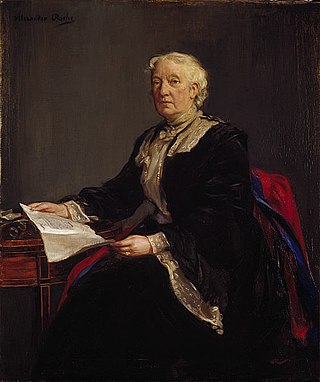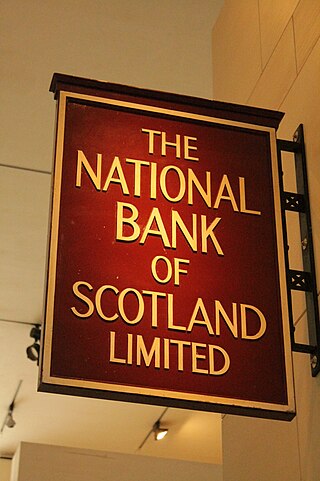
The Dean Cemetery is a historically important Victorian cemetery north of the Dean Village, west of Edinburgh city centre, in Scotland. It lies between Queensferry Road and the Water of Leith, bounded on its east side by Dean Path and on its west by the Dean Gallery. A 20th-century extension lies detached from the main cemetery to the north of Ravelston Terrace. The main cemetery is accessible through the main gate on its east side, through a "grace and favour" access door from the grounds of Dean Gallery and from Ravelston Terrace. The modern extension is only accessible at the junction of Dean Path and Queensferry Road.

David Alan Stevenson was a lighthouse engineer who built 26 lighthouses in and around Scotland.
James Moncreiff, 1st Baron Moncreiff of Tullibole LLD was a Scottish lawyer and politician.
Sir Thomas Fulton Wilson McKillop, FRS, FRSE is a Scottish chemist, who was CEO of AstraZeneca PLC from 1999 until 2006 and chairman of the RBS Group from 2006 until 2008.

Flora Clift Stevenson was a British social reformer with a special interest in education for poor or neglected children, and in education for girls and equal university access for women. She was one of the first women in the United Kingdom to be elected to a school board.
Adam and Company was a trading division of The Royal Bank of Scotland catering for the needs of private bank customers based in the United Kingdom. It offered a range of private banking services including discretionary investment management and financial planning services to high net worth clients in the UK.

The Royal Bank of Scotland plc is a major retail and commercial bank in Scotland. It is one of the retail banking subsidiaries of NatWest Group, together with NatWest and Ulster Bank. The Royal Bank of Scotland has around 700 branches, mainly in Scotland, though there are branches in many larger towns and cities throughout England and Wales. The bank is completely separate from the fellow Edinburgh-based bank, the Bank of Scotland, which pre-dates the Royal Bank by 32 years. The Royal Bank of Scotland was established in 1724 to provide a bank with strong Hanoverian and Whig ties.
Sir James David Marwick FRSE was a Scottish lawyer, historian and town clerk. He served as Town Clerk of Glasgow for thirty-one years, during which time the entire city was transformed. Its powers and amenities were improved by by-laws and Acts of Parliament, and Marwick directed the city of Glasgow's development for much of the second half of the 19th century.

Benjamin Hall Blyth FRSE, often called Benjamin Blyth II, was a Scottish civil engineer.

Charles John Guthrie, Lord Guthrie FRSE FRSGS LLD was a Scottish judge and lawyer.
Benny Higgins is a Scottish banker, and is the former chief executive officer (CEO) of Tesco Bank.

The National Bank of Scotland was founded as a joint stock bank in 1825. Based in Edinburgh, it had established a network of 137 branches at the end of its first hundred years. In 1918 the bank was bought by Lloyds Bank, although it continued to operate as an independent institution until 1959, when it merged with the Commercial Bank of Scotland to become the National Commercial Bank of Scotland. Ten years later the National Commercial Bank merged with the Royal Bank of Scotland.

Alexander Taylor Innes FRSE LLD, was a lawyer, writer, biographer and church historian. In authorship he is usually abbreviated as A.T.I.

Thomas ThomsonFRSE FSA Scot was a Scottish advocate, antiquarian and archivist who served as Principal Clerk of Session (1828–1852) and as secretary of the literary section of the Royal Society of Edinburgh (1812–20).
Archibald Campbell Swinton of Kimmerghame FRSE DL LLD, was a Scottish author, politician and professor of civil law at Edinburgh, 1862–72.

Archibald Campbell Douglas was a Scottish architect based primarily in Glasgow. He designed many churches in Glasgow and Edinburgh, especially those for the Free Church of Scotland.
William John Dundas, FRSE, LLD, WS (1849-1921) was a Scottish lawyer and mathematician. In later life he was a director of the Royal Bank of Scotland. He was the younger brother of James Dundas VC.

John Thomson FRS FRSE PRCPE (1765–1846) was a Scottish surgeon and physician, reputed in his time "the most learned physician in Scotland". He was President of the Royal College of Physicians of Edinburgh from 1834 to 1836.
Dr Alexander Bennett McGrigor of Cairnoch LLD (1827–1891) was a Scottish lawyer, university administrator and bibliophile. After his death he donated what is now known as the McGrigor Collection to Glasgow University Library.

Sir Alexander Kemp Wright KBE DL LLD (1859–1933) was a Scottish banker mainly associated with the Royal Bank of Scotland but with multiple banking roles. He founded the National Savings Movement.













